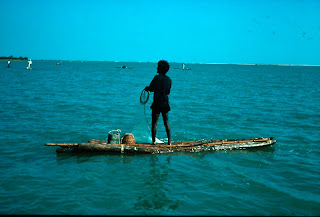About 60 different species of wetland birds have been observed, and many of them come from Central Asia and Eastern Europe. Ducks and geese, storks and ibises, pelicans and cormorants, herons and egrets, gallinules and different species of wading birds. Some of the commonest wetland birds include Shoveler, Garganey, Gadwall, Marsh Sandpiper and Black-tailed Godvit. In addition, resident birds such as Grey Pelican and Open-billed Stork are present. The beautiful Painted Stork is one of the most striking inhabitants of the lakeshore. This elegant bird with its pale red face and long and yellow curved beak is not that shy and can be easily approached when it walks in shallow water searching for prey with parts of its beak submerged half-open. The most spectacular sight in Pulicat Lake during the winter period is undoubtedly the huge numbers of flamingos, one of the most bizarre and outrageous birds to inhabit the earth.
Pic: fisherman in pulicat lake
Two species of flamingos occur in Pulicat Lake during the winter season, namely the Greater Flamingo and the Lesser Flamingo. Flamingos are dependent on shallow water to feed upon algae, diatoms or invertebrates. Pulicat Lake is the most important wintering area for flamingos in Asia, probably because this lake contains food items enough to maintain a population of about 15.000 individuals. To see thousands of flamingos taking flight and moving from one site to another is one of the greatest wildlife spectacles. The most important breeding area for flamingos wintering in Pulicat Lake is probably Great Rann of Kutch in the state of Gujarat.
Many wetland birds wintering in Pulicat Lake show a variety of migratory behaviour. Some birds breeding in the temperate regions such as ducks and waders undertake long distance annual migrations, whereas birds nesting in subtropical regions undertake short distance movements. Since pressure to “develop” the world’s wetland resources increases, information from migration is important in order to protect and conserve different bird populations.
Pic:Birds in lake
Many of the wetland birds arriving in Pulicat Lake usually come to this area year after year. This pattern is termed “site fidelity”, and this is an important feature of waterfowl migration. In many ducks, for example, the tendency for adult females to return to the natal area to breed, and for the male to disperse more widely in search of a mate, is well documented. Migratory waterfowl such as flamingos may also be highly traditional in their selection of staging areas and wintering sites, and Pulicat Lake must provide a good example in that way.

Pic : Pelican
Pulicat Lake is an example of a wetland where different purposes (e.g. feeding, breeding, resting etc.) for birds are taking place. Unfortunately, wetlands in many parts of the world continue to be lost, degraded and threatened, resulting in enormous pressures on wetland birds and other wetland biodiversity. As human influences on the earth increase, these pressures will continue to grow. Since Pulicat Lake also is facing environmental problems, such as siltation and over-fishing, it is strictly recommended to implement conservation programme for a sustainable development in this unique ecosystem. Research has to be done, and it is also important to inform people about the values of this unique ecosystem. In 2003, the Society Pulicat Lake Bird Lovers Society (PLBLS) was established in Sullurpet Town. The establishment of this Society is important because it is focusing about how to protect the biodiversity and also to educate people about nature conservation. Only wise and sustainable use of Pulicat Lake is essential because of its wonderful biodiversity and fundamental social and economic importance.
Article by:odd.w.Jacobsen,Ornithologist,Norway













